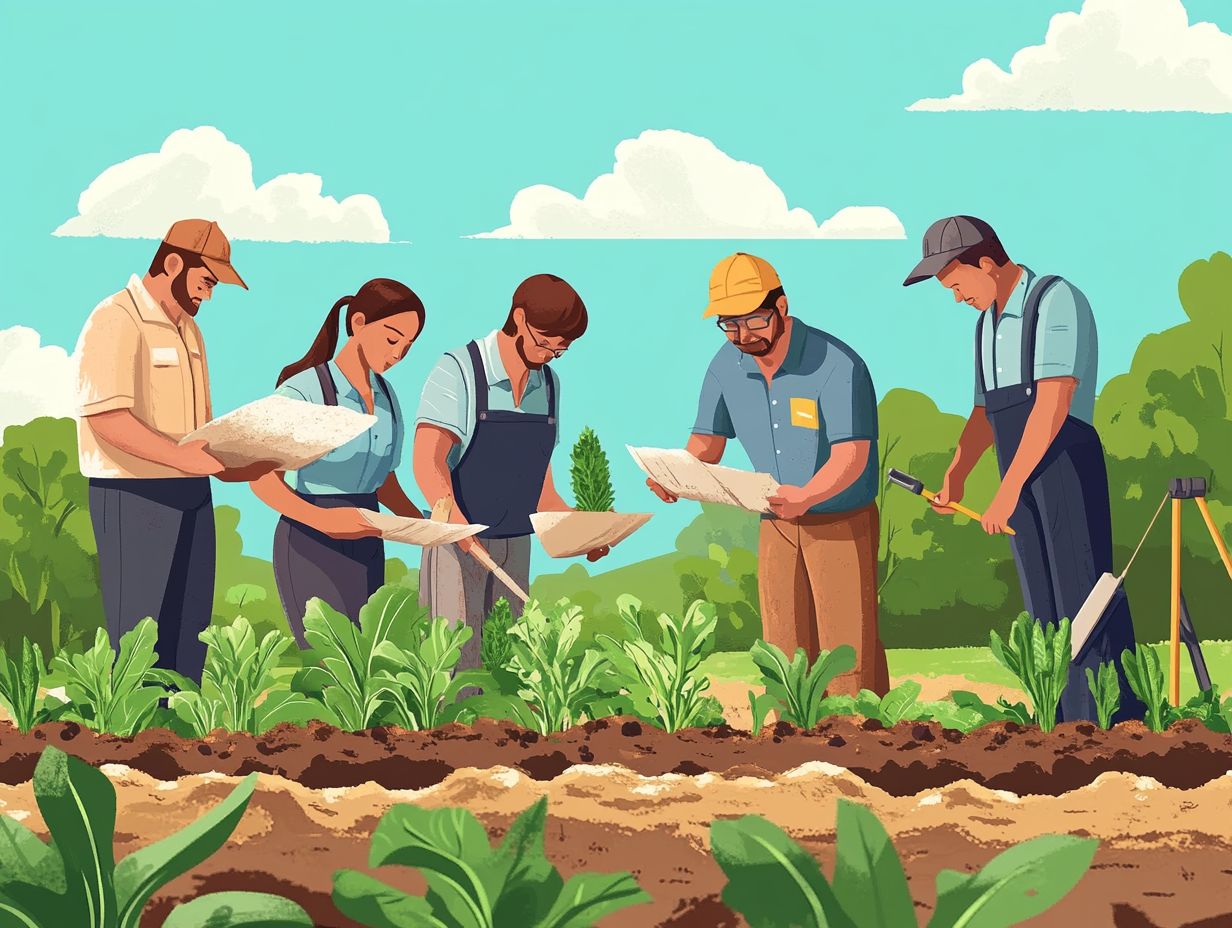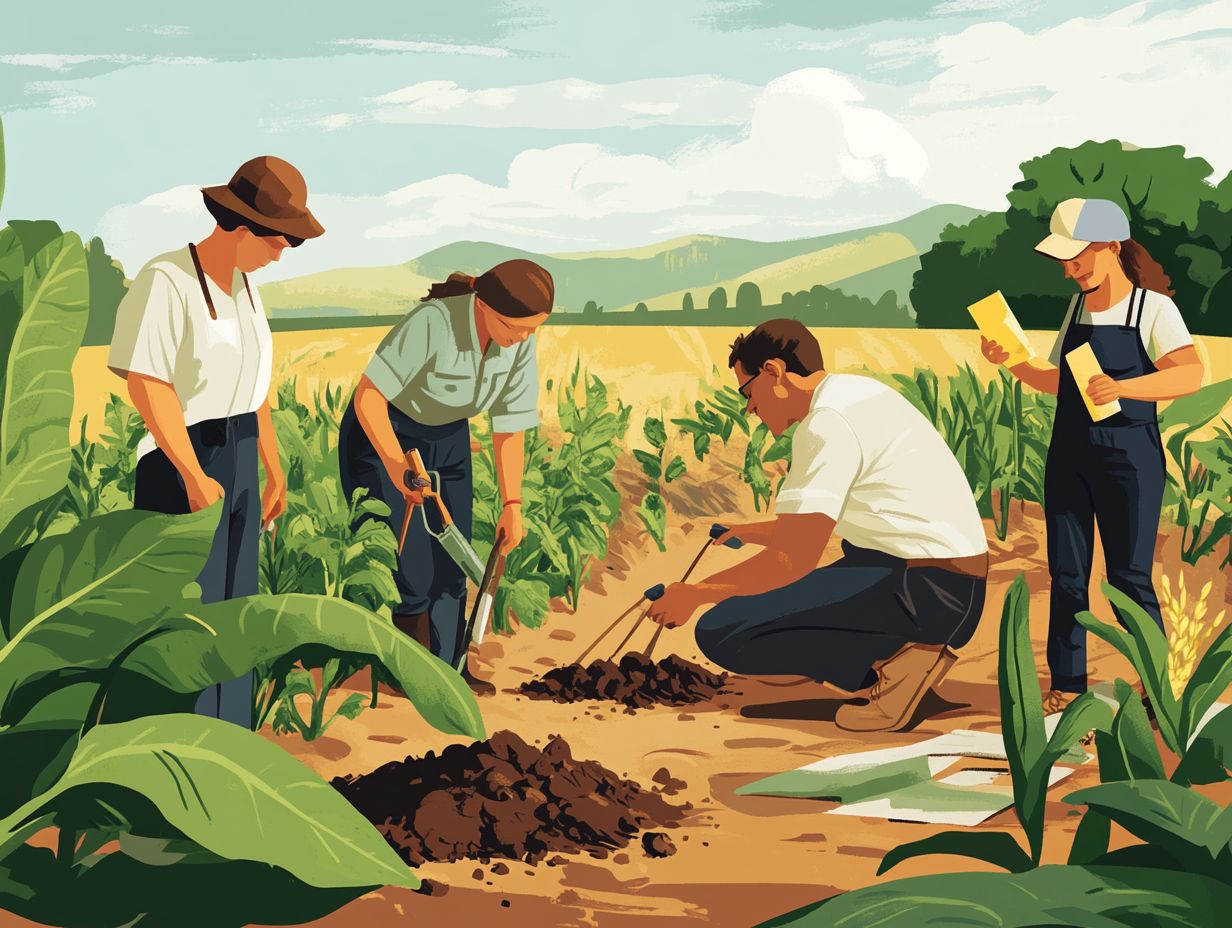How to Create a Soil Management Plan
Soil management stands as a cornerstone of sustainable agriculture and gardening. It influences everything from your crop yield to the overall health of the environment.
To craft an effective soil management plan, first understand the unique characteristics of your soil.
This guide delves into the significance of soil management, walks you through assessing your soil via testing and analysis, and outlines the essential components of a robust management strategy.
You ll find practical strategies for implementation and tips for maintaining and updating your plan to ensure optimal soil health.
Dive in to uncover how to nurture your soil for enhanced productivity and sustainability!
Contents
- Key Takeaways:
- Understanding Soil Management
- Assessing Your Soil
- Creating a Soil Management Plan
- Implementing Your Plan
- Practical Techniques and Strategies
- Maintaining and Updating Your Plan
- Regular Assessment and Adjustments
- Frequently Asked Questions
- What is a soil management plan and why is it important?
- How do I create a soil management plan?
- What should be included in a soil management plan?
- Who should be involved in creating a soil management plan?
- Can a soil management plan be tailored to specific crops or areas?
- How often should a soil management plan be reviewed and updated?
Key Takeaways:

- A solid soil management plan brings many benefits, like better crop yields and healthier soil, contributing to overall food sustainability.
- Before creating a plan, assess your soil through testing and analysis to identify its specific needs.
- A successful soil management plan should include key components such as nutrient management, erosion control, and regular updates for long-term success.
Understanding Soil Management
Understanding soil management is essential for sustainable agriculture. It involves techniques designed to enhance soil health and promote robust crop growth while minimizing environmental impacts.
Focus on creating a comprehensive soil management plan that considers soil texture, structure, and organic matter. This approach can significantly improve your crop yields and foster long-term soil sustainability.
Effective soil management helps you identify soil pollutants and address soil compaction issues, enhancing biodiversity and reducing greenhouse gases in the atmosphere.
Importance and Benefits of a Soil Management Plan
A well-structured soil management plan is critical for optimizing crop yields and ensuring long-term soil health. This approach cultivates sustainable farming practices, including runoff reduction and soil erosion control.
By implementing a robust soil management strategy, you enhance soil structure and texture, effectively reducing nutrient leaching and minimizing water pollution, ultimately fostering a healthier ecosystem.
Regularly assessing your soil s nutrient levels and organic matter content allows for informed fertilization decisions that lead to improved nutrient management and enhanced crop productivity. Such plans encourage practices like cover cropping and crop rotation, boosting biodiversity and supporting carbon sequestration, which means capturing and storing carbon dioxide to combat climate change while minimizing soil erosion.
The cumulative effect? You enjoy higher yields and nurture an improved soil microbiome that supports vibrant plant growth while decreasing reliance on chemical inputs.
This holistic approach benefits your farm and positively impacts the surrounding environment, championing sustainable agricultural practices essential for the future.
Assessing Your Soil
Assessing your soil is an essential step in effective soil management. It offers critical insights into its texture, acidity, and organic matter content. This assessment helps you conduct a comprehensive soil risk assessment, identifying both potential risks and opportunities for enhancement.
Regular soil testing and analysis are paramount for understanding nutrient levels, soil compaction issues, and the overall health of your soil. With this knowledge, you can implement targeted management actions that boost crop growth and underscore your commitment to sustainability.
Soil Testing and Analysis

Soil testing and analysis are essential for understanding soil health and identifying nutrient composition.
It helps you make informed management decisions and detect potential pollutants, enabling you to identify nutrient deficiencies, soil compaction issues, and risks of nutrient leaching.
This insight ultimately guides your development of effective soil management strategies.
A systematic evaluation of soil samples allows you to measure key indicators of soil health, such as pH levels, organic matter content, and microbial activity.
These elements are crucial for plant growth and productivity.
The lab results will illuminate the availability of essential small nutrients and big nutrients, informing you of the necessary amendments to optimize your soil.
By addressing these identified imbalances or deficiencies, you can enhance your agricultural practices, leading to improved crop yields and sustainability.
Understanding your soil is important for preventing erosion and optimizing water retention.
This ensures that your farm remains productive, even in the face of changing environmental conditions.
This process is important for more than just chemical composition; it plays a vital role in fostering long-term soil fertility and supporting sustainable farming and healthy ecosystems.
Creating a Soil Management Plan
Developing a soil management plan requires a careful approach that includes assessing soil resources.
This ensures you understand flooding risks and integrate insights from environmental professionals.
Your plan should be comprehensive, focusing on management actions that enhance soil sustainability and respect the preservation of historic features.
It should also incorporate construction projects and acknowledge the ecological impacts of agricultural practices.
This holistic strategy will ensure that all aspects of soil health and conservation are addressed, including compliance with Environmental Protection Agency regulations and relevant excavation permits.
Key Components and Considerations
The essential elements of a soil management plan encompass a thorough soil health assessment and targeted management actions.
You must consider factors like soil texture, organic matter, and nutrient management, as these are critical for adopting a sustainable approach to agriculture.
By performing comprehensive soil health assessments, you can pinpoint specific issues such as pH imbalances or nutrient deficiencies that directly affect crop yields and ecological stability.
Implementing practices like cover cropping and crop rotation replenishes soil nutrients and cultivates a diverse ecosystem, providing habitats for beneficial organisms.
Incorporating organic amendments, such as compost and green manure, fosters microbial activity, resulting in a vibrant soil community.
These strategic management actions enhance soil fertility and contribute to the long-term sustainability of agricultural systems while safeguarding the environment.
Implementing Your Plan
Implementing your soil management plan requires a thoughtful approach, incorporating practical techniques and strategies designed to enhance soil health.
This involves taking deliberate actions to reduce soil compaction, optimize crop rotation, and embrace sustainable farming practices.
By doing so, you pave the way for improved crop yields and long-term soil sustainability.
Practical Techniques and Strategies

Practical techniques and strategies in soil management play a vital role in enhancing soil health and sustainability. Methods such as crop rotation, reducing soil compaction, and implementing runoff reduction practices improve soil structure and moisture retention.
These methods also contribute to the ecological balance within agricultural systems. By adopting diverse crop rotation schedules, you can naturally disrupt pest cycles and replenish essential nutrients, leading to better yields without relying heavily on chemical fertilizers.
Implementing practices like cover cropping and reduced tillage significantly alleviates soil compaction, creating a more favorable environment for beneficial microbes.
Incorporating runoff reduction techniques such as contour farming and establishing buffer strips minimizes erosion and prevents nutrient leaching. Together, these strategies cultivate a resilient ecosystem that supports sustainable agriculture and mitigates environmental impacts.
Maintaining and Updating Your Plan
Maintaining and updating your soil management plan demands a commitment to regular assessments and adjustments. This proactive approach ensures that your strategies remain relevant and effective while addressing emerging challenges like soil erosion and nutrient leaching.
Regular Assessment and Adjustments
Regularly assessing soil health is crucial for making timely adjustments to your management plan. This practice helps identify soil pollutants and potential flooding risks. Consistent monitoring ensures that your strategies effectively respond to changing conditions.
This process involves analyzing soil samples for nutrients, pH, and contaminants. By engaging in routine observations, you can detect any deterioration in soil quality or imbalances from previous management practices.
Implementing adaptive strategies based on data fosters healthy soil ecosystems and enhances long-term agricultural productivity. Incorporating these essential assessments into your routine can significantly bolster resilience against climate-induced challenges and improve crop yields.
Frequently Asked Questions
What is a soil management plan and why is it important?

A soil management plan is a document that outlines the steps for managing and maintaining soil health in a specific area. Healthy soil is crucial for plant growth and productivity, and a well-designed plan helps prevent soil degradation and improve land use sustainability.
How do I create a soil management plan?
To create a soil management plan, assess the current state of the soil, including composition, nutrients, and potential issues. Set goals for improving soil health and develop strategies to achieve them. It’s also important to continually monitor and evaluate the plan for necessary adjustments.
What should be included in a soil management plan?
A soil management plan should include a description of the area, soil characteristics, and an analysis of current soil health. It should outline specific goals, recommended practices, and a timeline for implementation. Additionally, include a monitoring process to track progress and make changes as needed.
If you have more questions, feel free to reach out for assistance!
Who should be involved in creating a soil management plan?
Creating a soil management plan requires teamwork. Involve experts in soil science, agronomy, and land management.
It’s also vital to include people like farmers, landowners, and community members. Their insights can enhance the plan’s effectiveness and acceptance.
Can a soil management plan be tailored to specific crops or areas?
Yes! A soil management plan must be tailored to specific crops or areas for the best results. Different crops have unique nutrient needs and soil types.
Regions may also have special soil characteristics to consider. Customizing the plan ensures it meets local demands.
How often should a soil management plan be reviewed and updated?
Review your soil management plan at least once a year. Regular checks help assess its effectiveness and adjust for changes in soil conditions.
Moreover, it’s wise to revisit the plan after significant weather events or disturbances that might affect soil health.






